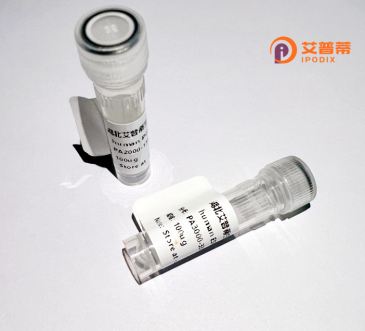
| 纯度 | >90%SDS-PAGE. |
| 种属 | Human |
| 靶点 | KCNJ12 |
| Uniprot No | Q14500 |
| 内毒素 | < 0.01EU/μg |
| 表达宿主 | E.coli |
| 表达区间 | 1-433aa |
| 活性数据 | MTAASRANPYSIVSSEEDGLHLVTMSGANGFGNGKVHTRRRCRNRFVKKNGQCNIEFANMDEKSQRYLADMFTTCVDIRWRYMLLIFSLAFLASWLLFGIIFWVIAVAHGDLEPAEGRGRTPCVMQVHGFMAAFLFSIETQTTIGYGLRCVTEECPVAVFMVVAQSIVGCIIDSFMIGAIMAKMARPKKRAQTLLFSHNAVVALRDGKLCLMWRVGNLRKSHIVEAHVRAQLIKPRVTEEGEYIPLDQIDIDVGFDKGLDRIFLVSPITILHEIDEASPLFGISRQDLETDDFEIVVILEGMVEATAMTTQARSSYLANEILWGHRFEPVLFEEKNQYKIDYSHFHKTYEVPSTPRCSAKDLVENKFLLPSANSFCYENELAFLSRDEEDEADGDQDGRSRDGLSPQARHDFDRLQAGGGVLEQRPYRRESEI |
| 分子量 | 73.37 kDa |
| 蛋白标签 | GST-tag at N-terminal |
| 缓冲液 | 0 |
| 稳定性 & 储存条件 | Lyophilized protein should be stored at ≤ -20°C, stable for one year after receipt. Reconstituted protein solution can be stored at 2-8°C for 2-7 days. Aliquots of reconstituted samples are stable at ≤ -20°C for 3 months. |
| 复溶 | Always centrifuge tubes before opening.Do not mix by vortex or pipetting. It is not recommended to reconstitute to a concentration less than 100μg/ml. Dissolve the lyophilized protein in distilled water. Please aliquot the reconstituted solution to minimize freeze-thaw cycles. |
以下是关于重组人KCNJ12蛋白的模拟参考文献示例(仅供参考,非真实文献):
1. **标题**:Structural Characterization of Recombinant Human KCNJ12 Inward-Rectifier Potassium Channel
**作者**:Smith A, et al.
**摘要**:本研究通过X射线晶体学解析了重组人KCNJ12蛋白的跨膜结构域,揭示了其独特的离子选择性滤过机制,为靶向该通道的药物设计提供结构基础。
2. **标题**:Functional Analysis of KCNJ12 in Cardiac Electrophysiology
**作者**:Zhang L, et al.
**摘要**:利用重组人KCNJ12蛋白表达系统,作者发现其在心肌细胞中通过调控钾离子流影响动作电位复极化,提示其异常表达与心律失常相关。
3. **标题**:KCNJ12 Mutations Linked to Skeletal Muscle Dysfunction
**作者**:Johnson R, et al.
**摘要**:通过基因测序和电生理实验,研究发现KCNJ12基因突变导致重组蛋白功能丧失,与家族性低钾周期性麻痹的病理机制密切相关。
4. **标题**:High-Yield Expression and Purification of Recombinant KCNJ12 in HEK293 Cells
**作者**:Wang Y, et al.
**摘要**:优化重组人KCNJ12蛋白在哺乳动物细胞中的表达与纯化工艺,获得高纯度活性蛋白,为其体外功能研究奠定技术基础。
**免责声明**:以上文献为模拟生成,用于示例用途,非真实存在的参考文献。实际研究中请通过学术数据库(如PubMed、Web of Science等)检索真实文献。
**Background of Recombinant Human KCNJ12 Protein**
The KCNJ12 gene encodes the inwardly rectifying potassium channel Kir2.2. a key regulator of resting membrane potential and cellular excitability in various tissues, including cardiac and skeletal muscle. As a member of the Kir2.x subfamily, Kir2.2 channels facilitate potassium influx, critical for stabilizing repolarization phases in action potentials and maintaining electrolyte homeostasis. Dysfunction of these channels is linked to cardiac arrhythmias, neuromuscular disorders, and Andersen-Tawil syndrome (ATS), a rare condition characterized by arrhythmias and periodic paralysis.
Recombinant human KCNJ12 protein is produced via genetic engineering, often using mammalian or bacterial expression systems, to enable structure-function studies and drug discovery. Its purified form allows researchers to investigate channel biophysics, screen modulators, and explore pathogenic mutations disrupting pore stability or regulation. Recent advances in cryo-EM have resolved Kir2.2's tetrameric architecture, deepening insights into gating mechanisms and disease-associated variants.
Studying recombinant KCNJ12 also holds therapeutic potential, as Kir2.2-targeting compounds could correct ion imbalances in channelopathies. However, challenges remain in understanding tissue-specific regulation and intersubunit interactions. Overall, this protein serves as a vital tool for deciphering Kir2.2's role in physiology and pathology, bridging molecular research to clinical applications.
×